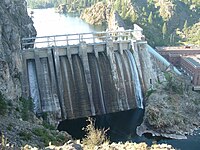Spokane River
The Spokane River is a tributary of the Columbia River, approximately 100 mi (161 km) long, in northern Idaho and eastern Washington in the United States. It drains a low mountainous area east of the Columbia, passing through the city of Spokane, which shares its name with the river. Heavily used for irrigation and drinking water, its watershed comprises a region of extensive farming and timber production. The lowered water levels in the river have resulted in an ongoing pollution crisis and a political struggle over its resolution.
Description

The Spokane River rises out of Lake Coeur d'Alene in the Idaho Panhandle, draining from the northwest corner of the lake near the city of Coeur d'Alene. It flows west approximately 25 mi (40 km) into east central Washington to Spokane, where it receives the Hangman River from the south.
From Spokane it flows northwest, receiving the Little Spokane River from the east approximately 10 mi northwest of the city. It flows in a zigzag course along the southern edge of the Selkirk Mountains, forming the southern boundary of the Spokane Indian Reservation, where it is impounded by the Little Falls Dam, and to form Long Lake, a 15 mi (24 km) reservoir. It joins Franklin D. Roosevelt Lake on the Columbia from the east at Miles. The site of historic Fort Spokane is located at the mouth of the river on the Columbia.
Crisis on the river
Much of the river's water, particularly during the summer, comes from underground springs fed by the Spokane-Rathdrum Aquifer. The aquifer provides drinking water for 400,000 people in the Spokane area, as well as extensive irrigation water along its course. The use of the aquifer water is so extensive that Spokane Falls, the signature natural feature of the city of Spokane, runs dry during many summers, with all the water being diverted to the Upper Falls and Lower Falls hydroelectric power plants. The lowered water levels have raised the toxicity of the stream, resulting in low concentrations of dissolved oxygen and algae blooms along much of the river's lower course.
In 2002 the Environmental Protection Agency issued a Superfund cleanup plan for the Spokane River-Lake Coeur d'Alene basin. In a controversial move, the Bush administration transferred control of the Idaho portion to the state of Idaho, which opposes the Superfund designation and the cleanup, partly based on its high cost and possible effect on real estate prices.
Fish Habitat

The Spokane River supports populations of rainbow trout, northern pikeminnow, and bridgelip suckers (see Catostomidae), as well as several non-native species. It supported several species of salmon until the construction of Long Lake Dam in 1915 by Washington Water Power blocked upstream passage.[1]
See also
External links
- ^ John Fahey, "Power Plays: The Enigma of Little Falls," Pacific Northwest Quarterly 82, no.4 (October 1991), 122-131.
